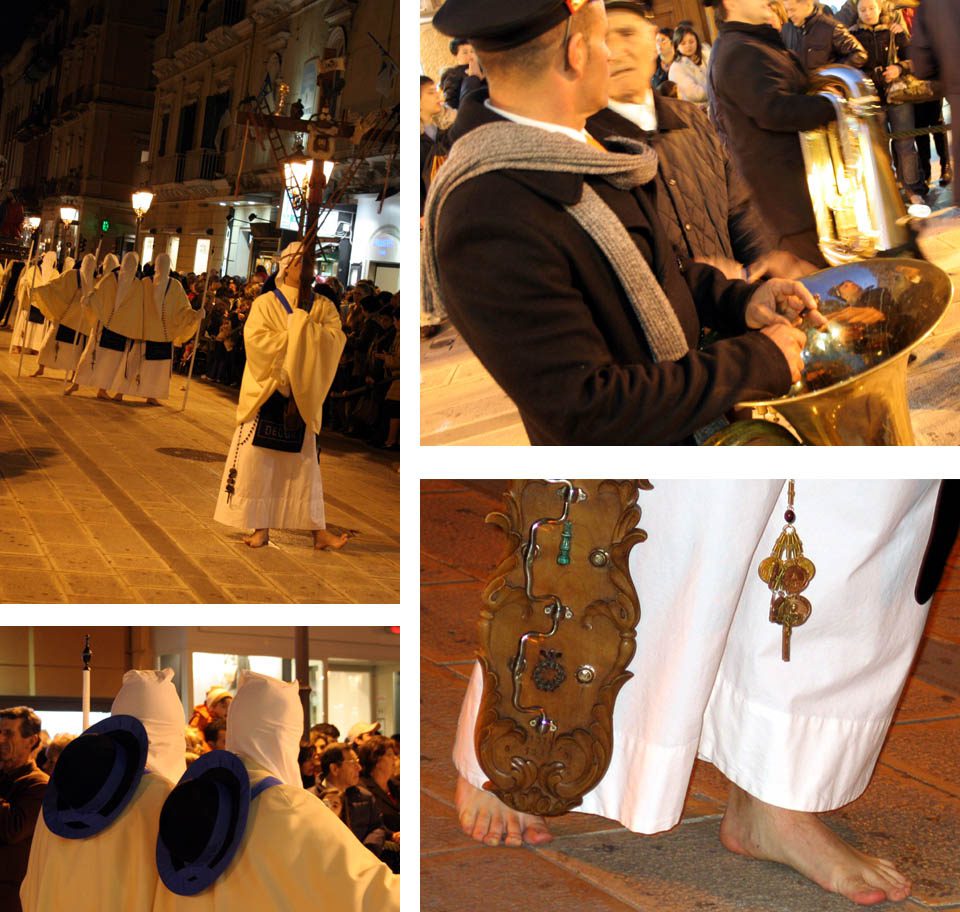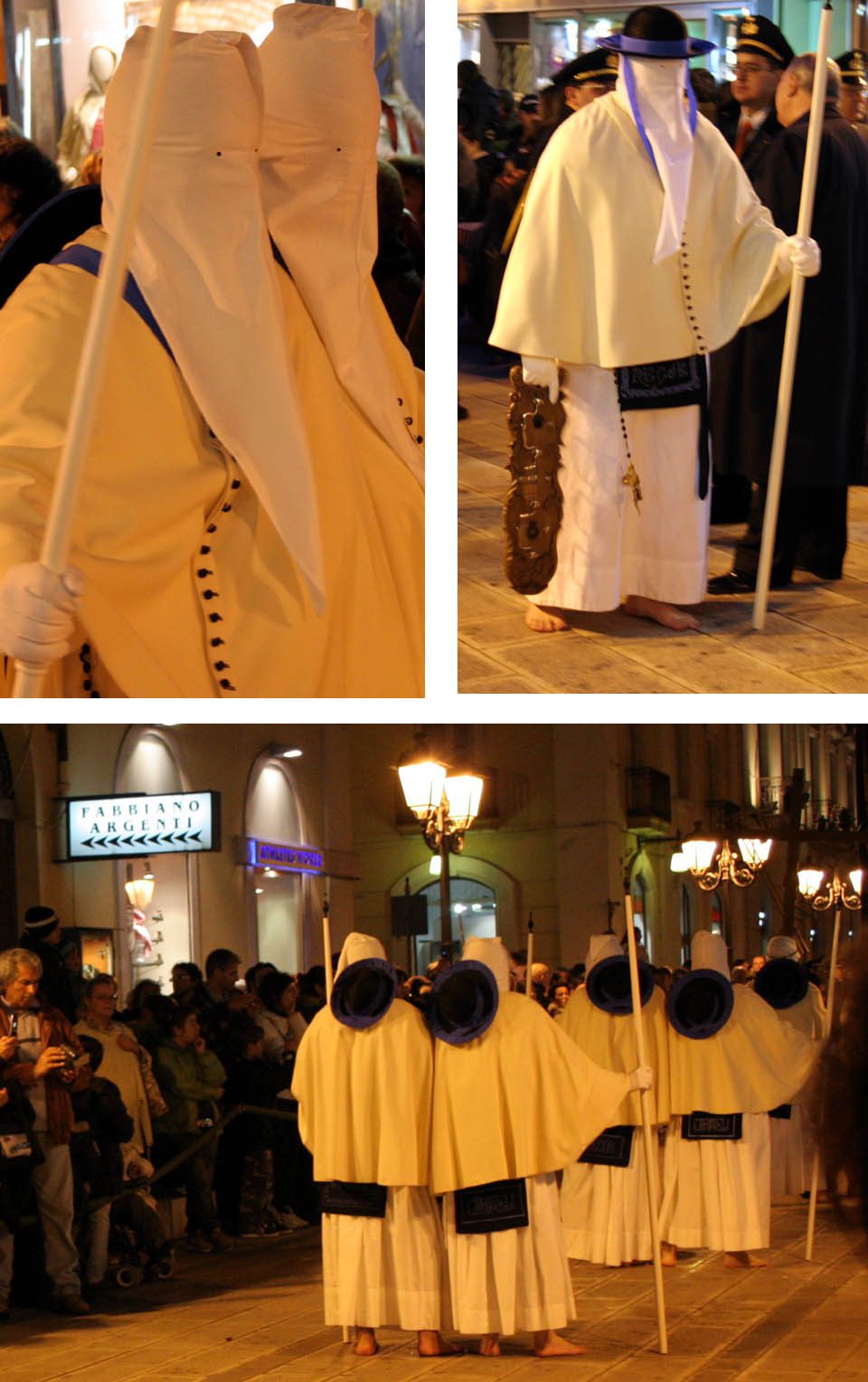The Mysterious Easter Traditions in Taranto
A Haunting Venerdi Santo Experience
Easter in Italy is celebrated in all its regional glory, and nowhere is this more evident than in Taranto, where some truly strange and mysterious traditions come to life. One of the most intriguing is the solemn, eerie processions that take over the streets on the Friday before Easter – Venerdi Santo.
We arrived in Taranto early evening, hoping to find a parking space. The city was packed. Every inch of curb from Lungomare to San Vito seemed taken, forcing us to leave the car miles from the center. Despite this, the walk back was enjoyable, giving us a perfect view of the huge red sun setting behind anchored ships and towering cranes. The scene cast long shadows over the sea, creating a silhouette that seemed to mirror the evening’s somber mood.
Then, from somewhere ahead, a sound cut through the evening air – a strange, rhythmic rattling, almost like bones clattering. It was the troccola, a wooden board rattled to mimic the stones hurled at Christ on His way to the cross. It’s a sound unique to Taranto’s Easter, and the tradition here is unlike anything you’ll find even in nearby towns like Grottaglie and Francavilla Fontana.
The sound of the troccola blended with a slow, mournful funeral march as the procession finally came into view. Leading the way was a man carrying a wooden cross adorned with mysterious symbols. His face was uncovered, and his barefoot steps made a strange, rhythmic flick with each slow stride forward. It was almost hypnotic, as if he was dancing in time with some invisible pulse.
Behind him, pairs of perdoni – pilgrims seeking absolution – swayed forward in unison. Their white robes and hoods hid their faces entirely, with only tiny pinpricks for eyes. Together, they moved side by side, shoulder to shoulder, as if connected, creating the unsettling image of a three-legged ghost drifting through the streets. The scene was hypnotic, each slow step carrying a sense of both mystery and gravity.
Building Anticipation
As the hours passed, the procession wound through the city, drawing reverent crowds. Strong men, dressed in traditional costumes, took turns shouldering heavy statues depicting the suffering of Christ and other scenes from the testaments. I decided not to wait for the famous Black Madonna, knowing she wouldn’t appear until midnight. By then, the motor-driven processions would take over, filling the streets with chaotic traffic and breaking the solemn mood of the night.
Meanwhile, the pedestrian streets filled with people, families of all generations claiming spots to witness the spectacle. Four-generation clusters chatted and laughed, pushing and squeezing their way through the crowd. Strangers became temporary neighbors, sharing the excitement as the night stretched on.
Finally, as darkness fully settled, the energy shifted. A hush swept through the crowd, anticipation at its peak. We craned our necks for a glimpse of the procession, but it always seemed just out of reach, drawing us deeper into the experience. The wait felt endless, yet it was this patience that allowed us to fully appreciate the weight of the night’s significance.
Want to discover more unique Italian traditions? Check out our guide to Easter in Francavilla Fontana and Oria.
This post was last updated in October 2024



I can see why you like Italy so much, especially at Easter. I would come to see the costumes as well, but would probably pass on waiting until midnight for the Black Madonna.
Wow, I know what you mean with the ‘eerie.’ Those costumes are very strange. would love to witness it all though, it’s certainly a spectacle!
Julia
The hooded men look interesting, though slightly ominous. I think I prefer our way of celebrating Easter: 10 days off work/school, mostly spent outdoors, skiing, eating oranges and marzipan eggs, and – for some peculiar reason no one really knows – read crime books or watch crime series on TV.
I like the Nordic tradition of doing nothing much as well. We must surely be among the most pious people in the world with 5 public holidays to meditate in celebration of Easter.
Actually the procession goes on all night! My husband’s family is from Taranto and live on the main square of the area you were taking photos in. We have often watched the processions from their balcony!
I think it goes on all night from Thursday to Friday. But after the great procession Friday evening it stops.
Very interesting! I did not know about this tradition. Thanks for sharing.
It’s impossible to keep track of all the Easter traditions in Italy. The change from one town to the next, which means with 10 km intervals in some places.
I was born and bred in Taranto. These traditions were passed on from the era of spanish occupation in south and west of Italy. Different localities have adopted somewhat different
approach. In Spain is also celebrated in a big way.
Interesting that the Easter traditions in Taranto and elsewhere in South Italy came with the Spaniards, and I can see the similarities. I would think some of the traditions were older than the Spanish occupation.
But exactly when please i need to know the datas
Thanks
The pilgrims depart from Chiesa di Maria Santissima del Monte Carmelo (on the pedestrianized shopping street) on Maundy Thursday March 29, 2018, and walk around to all the churches in the city. They start in the afternoon and depart at regular intervals in order to be finished by midnight. At midnight there’s a procession called Processione della Madonna Addolorata from Chiesa di San Domenico and they keep walking for 14 hours. Then there is a 1 hour break before the grand Processione dei Misteri starts at 3 pm on Good Friday (March 30, 2018). This procession goes on and on for 15 hours until 7 am Saturday morning. In other words: You cannot miss the Easter traditions, if you are in Taranto by the end of next week.